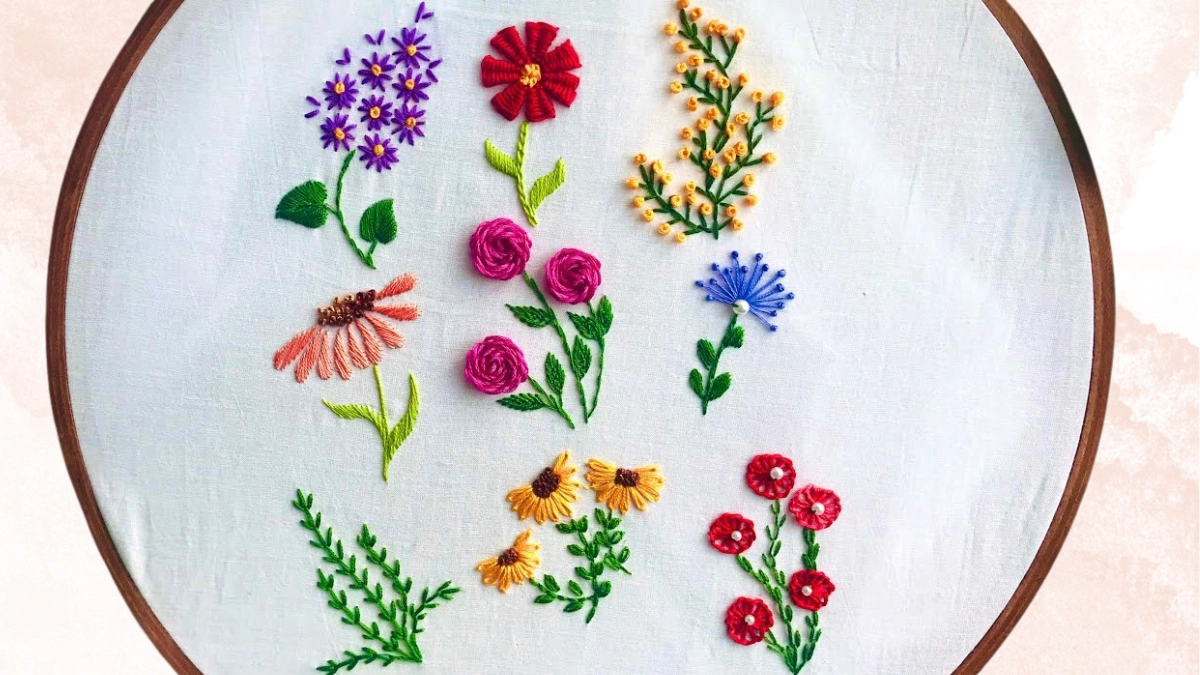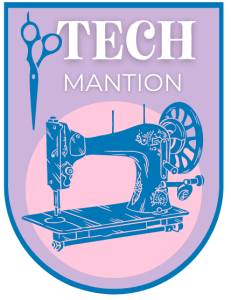Tired of scrolling through endless online shops for that perfect, eye-catching outfit?
What if the key to a refreshed and unique wardrobe was already at your fingertips?
Embroidery offers an affordable and enjoyable way to breathe new life into your clothes, and it starts with learning how to embroider flowers on clothes. In this article, we’ll show you how to turn a plain garment into a work of art with just a needle and thread.
We’ll cover everything from basic stitches for flowers to placing your floral designs on different fabrics, empowering you to make a fashion statement that is truly your own. So grab your embroidery hoop, and let’s stitch a path to a more colorful and customized wardrobe.
Table of Contents
Flower Embroidery on Clothing
Flower embroidery can transform a simple piece of clothing into a unique and elegant garment. This section guides through the fabric and thread selection, the most straightforward flowers for beginners, and the appropriate areas on clothing for embroidery.
Fabric Selection for Embroidery
Selecting the right fabric is crucial for embroidery. Natural fabrics like cotton, linen, or silk offer a sturdy base, while stretchy or loosely woven fabrics pose challenges. For beginners, medium-weight cotton is advisable as it provides stability and ease of stitching.
| Fabric Type | Best Used For |
|---|---|
| Linen | Traditional embroidery, household items |
| Cotton | General embroidery, clothing, quilting |
| Aida Cloth | Cross-stitch, beginner projects |
| Evenweave | Counted thread embroidery, cross-stitch |
| Canvas | Needlepoint, heavy-duty projects |
| Silk | High-end embroidery, delicate designs |
| Polyester Blend | Everyday wear, practice pieces |
Choosing the Right Threads
Threads determine the vibrancy and texture of the embroidery. Cotton embroidery floss is widely used due to its versatility and vast color range. For a shimmering effect, one might consider silk or rayon threads. It’s important to choose threads that match the fabric’s weight and intended care routine.
| Thread Type | Best Used For |
|---|---|
| Cotton | General embroidery, versatile applications |
| Silk | High-end projects, smooth and glossy finish |
| Rayon | High sheen, delicate work, machine embroidery |
| Polyester | Durable, colorfast, everyday use |
| Wool | Crewel embroidery, thick and textured designs |
| Metallic | Decorative accents, special effects |
| Variegated | Multi-colored patterns, artistic designs |
| Nylon | Clear thread, invisible stitching |
| Linen | Traditional embroidery, heirloom quality |
| Specialty Fibers | Novelty effects, unique textures |
Can you embroider directly onto clothes?
One can certainly embroider directly onto clothes. However, ensure the clothing item is not too stretchy or delicate for the embroidery process. Using an embroidery hoop and stabilizer can provide the necessary tension and support.
What is the easiest flower to embroider?
The daisy is often considered the easiest flower to embroider due to its simple structure. It typically requires just a few straight stitches for the petals, and a French knot or a small satin stitch can create the center.
What areas of clothing can you embroider?
Embroidery can be placed on various areas of clothing such as necklines, cuffs, hems, or even alongside seams. Smaller, flatter areas are generally easier to work with, especially for beginners.
How do you transfer a pattern onto fabric embroidery?
To transfer a pattern onto fabric for embroidery, you can use a transfer pencil or pen to trace the design onto tracing paper, then iron it onto the fabric, or you can employ a water-soluble stabilizer that prints the design and adheres to the fabric, dissolving after stitching.
Embroidery Flower Stitches
Embroidering flowers onto clothing can add a personal touch and enhance the garment’s visual appeal. Distinct stitches can be used to create various floral designs, each with its texture and style.
Straight Stitch: A fundamental technique perfect for beginners. It involves pulling the needle through the fabric and then back down, creating a single straight line. Sequential straight stitches can form petals for a simple flower.
Satin Stitch: Used to fill in the petals of an embroidery flower with smooth, satin-like stitches that lie flat against the fabric. It’s a versatile stitch that can create solid coverage and is effective for adding dimension. Learn more about satin stitched flowers.
French Knot: A technique for creating small, rounded elements such as the center of a flower. The thread is wound around the needle to create a knot and then anchored into the fabric.
Lazy Daisy: This stitch is excellent for creating individual flower petals with a looped, slightly raised effect. It resembles a chain stitch in the shape of a petal and is easy to work into floral designs.
Buttonhole Stitch: Also known as the blanket stitch, it can be used around the edges of the flower to provide a clean and defined border. It’s particularly useful for wheel flowers.
The choice of stitch depends on the desired effect and the embroiderer’s skill level. With practice, these stitches can be combined to create intricate and beautiful floral hand embroidery on any garment.
Flower Embroidery on Different Clothing
Incorporating floral embroidery into various clothing items personalizes and enhances the aesthetic appeal. Each garment requires a unique approach to achieve the best results.

Embroider Flowers on a Shirt
When embellishing a shirt with flowers, placement is key. Positioning flowers along the collar or cuff adds a touch of elegance. Lightweight threads prevent the fabric from puckering and maintain the shirt’s comfort.
Embroider Flowers on Shoes
Adding embroidery to shoes transforms plain footwear into custom pieces. For canvas shoes, simple stitches like the straight stitch effectively create vivid flower designs. It’s crucial to use a sturdy needle that can pierce the shoe material.
Read our full article on how to embroider flowers on converse shoes for a beginners’ guide.
Embroider Flowers on Smocking
Smocking provides an ideal canvas for delicate flowers. The gathered fabric accentuates embroidered petals and makes them stand out. Selecting thin threads mirrors the intricacy of the smocking pleats.
Embroider Flowers on Jeans
Jeans offer a rugged contrast to the softness of flowers, making them an ideal canvas for showcasing your embroidered blooms.
Utilize robust floss that can handle the thick denim fabric, focusing on areas like pockets and seams for a subtle yet striking effect, and consider using a sharper needle to easily penetrate the material, ensuring your floral designs are not only beautiful but also durable.
We explained on how to embroider flowers on jeans in this article.
Embroider Flowers on Crochet
Crocheted items with their open weave patterns serve as a natural grid for embroidery. Embroidering on crochet should involve minimal tension to avoid warping the openwork fabric design.
Embroidery Patterns for Flowers
Embroidering flowers adds a touch of elegance to any piece of clothing. Different stitches can create a range of effects from flat, delicate blooms to textured, three-dimensional floral designs.
Creating Flat Flowers with Satin Stitch
The satin stitch is ideal for filling in the petals of flowers, producing a smooth, flat appearance. To create a satin stitch flower, one first outlines the shape and then fills it with closely placed parallel stitches. Learn about various satin stitch flowers that can enhance your designs.
Dimensional Flowers with French Knots
For texture and dimension, the French knot is a versatile choice. They can be clustered to form the center of a flower or to create an entire bloom. The key to a successful French knot is to wrap the thread around the needle twice before inserting it back into the fabric.
Using the Lazy Daisy for Petals
The lazy daisy stitch, a variant of the chain stitch, is perfect for creating individual petals with a slightly raised effect. One forms a loop with the thread and secures it with a small stitch at the end to mimic the shape of a petal. Explore the lazy daisy technique for an array of floral designs.
Advanced Floral Embroidery Tips

Elevating embroidery to an advanced level requires skillful techniques and an understanding of how different materials can enhance the design. Mastery in the incorporation of beads and sequins, as well as blending threads to create gradient effects, can transform a simple embroidery into a work of art.
Incorporating Beads and Sequins
Beads and sequins add a distinctive sparkle and texture to embroidery. For a secure application, one should use a beading needle and opt for a double thread to reinforce the attachment of each bead and sequin.
It’s essential to distribute these embellishments evenly and to consider the weight they add to the fabric. An embroiderer may need to stabilize the fabric with an appropriate backing to prevent puckering.
Blending Threads for Gradient Effects
Creating gradient effects demands a fine blending of thread colors. One can achieve a seamless transition by using two-thread blending techniques where two different colored strands are combined in a single needle.
Artists should start with the darkest shade and progressively move towards the lighter tones, carefully selecting hues that complement each other. This technique can be particularly effective when rendering petals and leaves to give them a more realistic appearance.
Caring for Embroidered Clothing
Proper care of embroidered clothing is essential for maintaining its appearance and longevity. It requires specific handling during washing, ironing, and storage to keep the embroidery intact and vibrant.
Washing Embroidered Clothes
- Hand Washing: Embroidered items should be hand-washed delicately using mild detergent. Soak the garment in cold water, gently agitate by hand, and rinse until the water runs clear.
- Machine Washing: If machine washing is necessary, it’s recommended to use a gentle cycle with cold water and place the piece inside a mesh laundry bag for protection.
- Important Tips:
- Avoid harsh chemicals or bleaching agents.
- Do not wring out the embroidered sections.
- Lay flat to air dry, away from direct sunlight.
Ironing Embroidered Fabrics
- Preparation: Set the iron to the appropriate heat setting for the fabric type and ensure to turn the embroidered garment inside out to protect the design.
- Ironing: Use a pressing cloth between the iron and the fabric to avoid damage. Gently iron around the embroidery, never directly over it.
- Best Practice:
- For additional safety, iron the embroidery through a cloth from the front side of the fabric using gentle pressure.
Storing Embroidered Clothing Properly
- Folding: Always fold embroidered clothing along the seams to minimize creasing over the embroidery work. Avoid placing heavy items on top that could compress the embroidery.
- Hanging: Some items are best stored hung. Opt for padded hangers to prevent distortion of the shape and embroidery.
- Environmental Conditions:
- Store in a cool, dry environment to prevent mold or mildew.
- Avoid prolonged exposure to sunlight which can fade the embroidery.
FAQs on How to Embroider Flowers on Clothes
How to stitch flower stems?
To stitch flower stems, use the stem stitch, which involves creating overlapping forward stitches along the line of the stem for a twisted, rope-like appearance that is perfect for depicting the natural curve and thickness of stems in floral embroidery.
What fabrics can you not embroider on?
Fabrics that are overly stretchy, too thin or sheer, or have a very loose weave are typically challenging to embroider on without proper stabilization; materials like very lightweight silks, loosely knit sweaters, and high-stretch sports fabrics may require special techniques or stabilizers.
Can you hand embroider silk?
Yes, you can hand embroider silk, but it requires a gentle touch and proper stabilization as silk is a delicate fabric; using a hoop to keep the fabric taut and a fine needle can help achieve beautiful results.
What supplies do you need for embroidery?
The basic supplies for embroidery include an embroidery hoop to keep the fabric taut, a sharp needle, embroidery floss or threads, fabric suited to your project, and a pattern or design to follow.
Final Thoughts
In conclusion, mastering how to embroider flowers on clothes can transform your wardrobe into a garden of handmade beauty. With the right tools and techniques, you can breathe new life into fabric, turning simple garments into personalized works of art.
Whether you’re sprucing up a favorite piece or starting from scratch, the joy of embroidery awaits. So thread your needle with confidence and let your creativity bloom with each stitch you sew.








